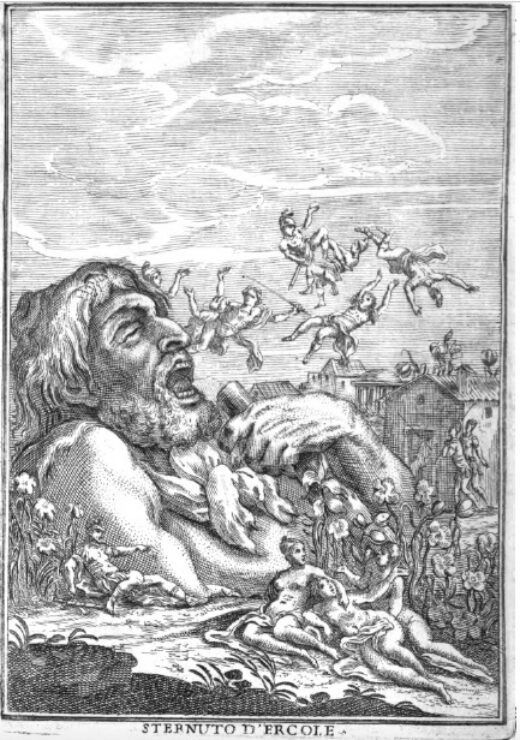
Printed
65 pages
Author(s)
Lo starnuto d'Ercole
Pier Jacopo Martello wrote Lo starnuto d’Ercole (Hercules’s sneeze) for puppets specifically. He defined this play as a “bambocciata” and included it in his complete collected works. The puppets were made of wood and moved with strings or springs. They faced a giant, Ercole (Hercules), in a spectacular arrangement built on contrasts: the Pygmies’ names are as short as they themselves are, and the length of their lines as well as the typography used for them in the first edition (Bologna, 1723) also parallel their shortness; this contrasts with Ercole, whose lines are written in normal-sized typeface . With this play, Martello seems to have marked the birth of string puppets in Italy.
After its first performance in 1717 in Rome, the play remained successful: in his Mémoires (Memoirs), Carlo Goldoni relates that he staged it in 1726 at the house of Count Lantieri, using a giant puppet for Ercole.
Most importantly, the play was adapted for a performance at the Labias’ Teatro di San Girolamo in Venice, for the carnival of 1745 (according to the publication) or of 1746 (according to historians). It is this adaptation which is described here. The play was now divided into three acts, instead of five; and Ercole was represented with only a nose and a hand, most likely those of a human actor.
Angelo Maria Labia (1709-1775) had this luxurious miniature theatre built in his palace, in the Cannaregio neighbourhood. The stages and scenery of this miniature theatre, built on the model of San Giovanni Grisostomo’s theatre, were moved by a complex machinery. Labia’s theatre was shown in private performances during the carnival. During the shows, Labia gave his guests in-24-sized libretti. Singers played behind the stage, on which the puppets were moved. For this performance, which the Modenese Duchess attended, the music was composed by Johann Adolf Hasse, also known as the Saxon; he was the choirmaster for the Polish king’s chapel. The choirs were directed by Andrea Adolfati, and the scenery designed by Tommaso Cassani.
A giant gives up on his plan to use force
Kom, king of the city of Polimicra, announces to his people that a giant is treading on their land. He promises his daughter to whoever defeats him: Occe, who is in love with Nec, therefore comes forward and offers himself as a champion. Although she pretends not to have feelings, Nec is secretly in love with the giant Ercole (Hercules). Vam, the Pygmies’ general, is in love with Has, Kom’s second daughter. But Has is in love with Occe. The envoy Brin announces the arrival of the giant; he describes him in horrifying terms: the giant Ercole demands the king’s two daughters, or he will destroy the city.
In the gardens of the palace, Nec and Has see the sky darken when the giant arrives. Has is desperate, but Nec rejoices: either her kingdom defeats him, or she will become Ercole’s wife. In the panic, a propitiatory sacrifice is made to Mammon, while the battle is being prepared. Brin is trying to accept that he will be devoured; the general Vam suggests that they put the giant to sleep to defeat him. Has declares his love to Occe, to try and stop him from the certain death awaiting him; but Occe’s decision does not change in the slightest. During the sacrifice, Has prays for the people, while Nec refuses to pray for the defeat of the one she loves: her father sends her to the dungeon. Brin arrives, distressed: Ercole’s nose is showing - it was taken for a mobile rock – and Ercole is asking for the king’s daughters. The giant makes fun of Occe, who is trying to fight him. Vam fills the place with smoke. Ercole sneezes: everyone falls to the ground and believes that they are being punished by the gods. They try to flee, but are stopped by Ercole’s hand. Only Nec stands before Ercole to declare her love. Out of pity and admiration for her bravery, Ercole commands Nec and Occe to marry, as well as Vam and Has, and he decides to spare everyone.
First performance
Publications and translations
Pier Jacopo Martello, Lo starnuto d'Ercole. Venezia: Luigi Pavini, 1745
Pier Jacopo Martello, Teatro, vol. 1. Bari: Laterza, 1980
